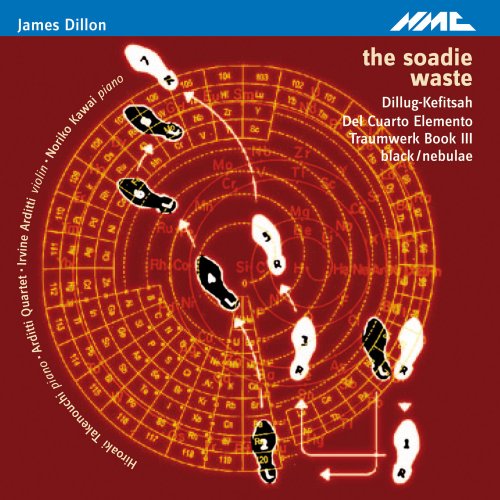
Noriko Kawai, Irvine Arditti, Arditti Quartet, Hiroaki Takenouchi - Dillon: The Soadie Waste, Dillug-Kefitsah, Del Cuarto Elemento, Traumwerk, Book 3 & black/nebulae (2012)
BAND/ARTIST: Noriko Kawai, Irvine Arditti, Arditti Quartet, Hiroaki Takenouchi
- Title: Dillon: The Soadie Waste, Dillug-Kefitsah, Del Cuarto Elemento, Traumwerk, Book 3 & black/nebulae
- Year Of Release: 2012
- Label: NMC Recordings
- Genre: Classical
- Quality: FLAC (tracks) / MP3 320 Kbps
- Total Time: 01:15:08
- Total Size: 273 / 193 Mb
- WebSite: Album Preview
Tracklist:
Dillug-Kefitsah (James Dillon)
1. Dillug-Kefitsah 03:20
Del cuarto elemento (James Dillon)
2. Del cuarto elemento 10:05
Traumwerk, Book 3 (James Dillon)
3. No. 1. eighth note = 42: Lontano (sul ponticello) senza vibrato 04:17
4. No. 2. eighth note = 96 01:36
5. No. 3. eighth note = 90 02:53
6. No. 4. eighth note = 63 02:12
7. No. 5. eighth note = 48: Lontano 02:40
8. No. 6. eighth note = 69: Analytic 00:47
9. No. 7. eighth note = 60 Sul tasto - Sul ponticello - Ad libitum sempre 03:56
10. No. 8. eighth note = 42 01:14
11. No. 9. eighth note = 72 02:42
12. No. 10. eighth note = 72 01:40
13. No. 11. eighth note = 112 01:44
14. No. 12. eighth note = 126 02:31
black/nebulae (James Dillon)
15. black/nebulae 20:04
The soadie waste (James Dillon)
16. the soadie waste 13:27
Performers:
Noriko Kawai
Irvine Arditti
Hiroaki Takenouchi
Arditti Quartet
Dillug-Kefitsah (James Dillon)
1. Dillug-Kefitsah 03:20
Del cuarto elemento (James Dillon)
2. Del cuarto elemento 10:05
Traumwerk, Book 3 (James Dillon)
3. No. 1. eighth note = 42: Lontano (sul ponticello) senza vibrato 04:17
4. No. 2. eighth note = 96 01:36
5. No. 3. eighth note = 90 02:53
6. No. 4. eighth note = 63 02:12
7. No. 5. eighth note = 48: Lontano 02:40
8. No. 6. eighth note = 69: Analytic 00:47
9. No. 7. eighth note = 60 Sul tasto - Sul ponticello - Ad libitum sempre 03:56
10. No. 8. eighth note = 42 01:14
11. No. 9. eighth note = 72 02:42
12. No. 10. eighth note = 72 01:40
13. No. 11. eighth note = 112 01:44
14. No. 12. eighth note = 126 02:31
black/nebulae (James Dillon)
15. black/nebulae 20:04
The soadie waste (James Dillon)
16. the soadie waste 13:27
Performers:
Noriko Kawai
Irvine Arditti
Hiroaki Takenouchi
Arditti Quartet
James Dillon was born in 1950 in Glasgow, and is now a Professor of Music at the University of Minnesota. He is often grouped as part of the British "New Complexity" school, but as far as I know he, like Brian Ferneyhough, does not identify himself as such.
This is a superb set of chamber works for piano and strings, performed by pianist Niriko Kawai, violinist Irvine Arditti, the Arditti Quartet, and pianist Hiroaki Takenouchi on the piano duet "black/nebulae:"
The earliest works, the solo pieces for piano and violin, are certainly devilishly complex for the performer, but they are not intimidating to the listener's ear. The lively, accessible folk-inflected tone only grows more pronounced in the later works, which are less dense. The cycle of 12 short pieces of Dreamwork Book III is relatively sparse, with repetitive ostinati in some sections (Part 9, for instance) that can sound like a skipping record, or compulsive behavior (and which leads to me dock this set one star). The piano duo is perhaps the most accessible to mainstream classical listeners, with flowing swirls of energy inspired by flocks of crows (hence "black") and astronomical objects.
The title piece also features a repetitive motif, a high note followed by a jagged, staccato lower note repeated several times. According to Dillon, quoted in the liner notes by Richard Toop, the name comes from "an old dance hall in Rutherglen (on the outskirts of Glasgow). 'The soadie waste' was the local name for the Territorial Army social club; it was built on the wasteland of an old chemical factory." So this is the source of the cover art -- dance steps over the chemical elements seeping up through the floorboards. This is another lively, engaging piece as played by Kawai and the Ardittis.
This is a superb set of chamber works for piano and strings, performed by pianist Niriko Kawai, violinist Irvine Arditti, the Arditti Quartet, and pianist Hiroaki Takenouchi on the piano duet "black/nebulae:"
The earliest works, the solo pieces for piano and violin, are certainly devilishly complex for the performer, but they are not intimidating to the listener's ear. The lively, accessible folk-inflected tone only grows more pronounced in the later works, which are less dense. The cycle of 12 short pieces of Dreamwork Book III is relatively sparse, with repetitive ostinati in some sections (Part 9, for instance) that can sound like a skipping record, or compulsive behavior (and which leads to me dock this set one star). The piano duo is perhaps the most accessible to mainstream classical listeners, with flowing swirls of energy inspired by flocks of crows (hence "black") and astronomical objects.
The title piece also features a repetitive motif, a high note followed by a jagged, staccato lower note repeated several times. According to Dillon, quoted in the liner notes by Richard Toop, the name comes from "an old dance hall in Rutherglen (on the outskirts of Glasgow). 'The soadie waste' was the local name for the Territorial Army social club; it was built on the wasteland of an old chemical factory." So this is the source of the cover art -- dance steps over the chemical elements seeping up through the floorboards. This is another lively, engaging piece as played by Kawai and the Ardittis.
Classical | FLAC / APE | Mp3
As a ISRA.CLOUD's PREMIUM member you will have the following benefits:
- Unlimited high speed downloads
- Download directly without waiting time
- Unlimited parallel downloads
- Support for download accelerators
- No advertising
- Resume broken downloads


